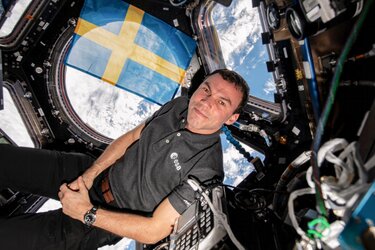Accept all cookies Accept only essential cookies See our Cookie Notice

About ESA
The European Space Agency (ESA) is Europe’s gateway to space. Its mission is to shape the development of Europe’s space capability and ensure that investment in space continues to deliver benefits to the citizens of Europe and the world.
Highlights
ESA - United space in Europe
This is ESA ESA facts Member States & Cooperating States Funding Director General Top management For Member State Delegations European vision European Space Policy ESA & EU Space Councils Responsibility & Sustainability Annual Report Calendar of meetings Corporate newsEstablishments & sites
ESA Headquarters ESA ESTEC ESA ESOC ESA ESRIN ESA EAC ESA ESAC Europe's Spaceport ESA ESEC ESA ECSAT Brussels Office Washington OfficeWorking with ESA
Business with ESA ESA Commercialisation Gateway Law at ESA Careers Cyber resilience at ESA IT at ESA Newsroom Partnerships Merchandising Licence Education Open Space Innovation Platform Integrity and Reporting Administrative Tribunal Health and SafetyMore about ESA
History ESA Historical Archives Exhibitions Publications Art & Culture ESA Merchandise Kids Diversity ESA Brand Centre ESA ChampionsLatest
Space in Member States
Find out more about space activities in our 23 Member States, and understand how ESA works together with their national agencies, institutions and organisations.
Science & Exploration
Exploring our Solar System and unlocking the secrets of the Universe
Go to topicAstronauts
Missions
Juice Euclid Webb Solar Orbiter BepiColombo Gaia ExoMars Cheops Exoplanet missions More missionsActivities
International Space Station Orion service module Gateway Concordia Caves & Pangaea BenefitsLatest
Space Safety
Protecting life and infrastructure on Earth and in orbit
Go to topicAsteroids
Asteroids and Planetary Defence Asteroid danger explained Flyeye telescope: asteroid detection Hera mission: asteroid deflection Near-Earth Object Coordination CentreSpace junk
About space debris Space debris by the numbers Space Environment Report In space refuelling, refurbishing and removingSafety from space
Clean Space ecodesign Zero Debris Technologies Space for Earth Supporting Sustainable DevelopmentLatest
Applications
Using space to benefit citizens and meet future challenges on Earth
Go to topicObserving the Earth
Observing the Earth Future EO Copernicus Meteorology Space for our climate Satellite missionsCommercialisation
ESA Commercialisation Gateway Open Space Innovation Platform Business Incubation ESA Space SolutionsLatest
Enabling & Support
Making space accessible and developing the technologies for the future
Go to topicBuilding missions
Space Engineering and Technology Test centre Laboratories Concurrent Design Facility Preparing for the future Shaping the Future Discovery and Preparation Advanced Concepts TeamSpace transportation
Space Transportation Ariane Vega Space Rider Future space transportation Boost! Europe's Spaceport Launches from Europe's Spaceport from 2012
New ways to space
Thank you for liking
You have already liked this page, you can only like it once!
ESA project astronaut Marcus Wandt in a training version of the European International Space Station module Columbus learning to operating robots from space at ESA’s technical heart ESTEC in The Netherlands.
The first in the new generation of ESA astronauts is getting ready to jump on a commercial spaceflight opportunity with Axiom Space.
Marcus Wandt, 43, was selected in November 2022 as a member of the ESA astronaut reserve after a year-long selection process. The 2022 ESA recruitment campaign received over 22 5000 applications from across its Member States.
Now the Swedish National Space Agency (SNSA) and ESA are cooperating to support Marcus’s mission using a commercial fast-track.
“What an exciting year! Everything took off so much faster than I ever would have expected!” said Marcus in his first tweet as an ESA project astronaut. The Swedish astronaut officially joined the European Astronaut Corps in this month.
“You could instantly tell that there was something special about Marcus when he entered the room for his final interview to become an astronaut,” said ESA director of Human and Robotic Exploration David Parker during a press conference in Stockholm, Sweden, on 16 June.
Marcus unveiled his mission name, Munnin, and patch. Muninn takes its name from Norse mythology and the two raven accomplices of the god Odin – Muninn and Huginn. Muninn comes from the Old Norse word munr, that can be translated as passion and emotion, linking to Marcus’s enthusiasm for spaceflight. Huginn is the name of ESA astronaut Andreas Mogensen’s International Space Station mission.
The patch shows the raven gliding around Earth to share the knowledge collected from Marcus’s mission and has several references to Marcus’s homeland and his career as a jet and test pilot for the Swedish Air Force.
The Swedish astronaut is following an intensive training programme to meet the high standards required for space flight. Marcus has followed lessons at the European Astronaut Centre in Germany and at ESA’s technical heart in the Netherlands, ESTEC. From teleoperating robots to virtual tours around the International Space Station and fundamental physics experiments, Marcus’s learning curve is steep.
ESA and SNSA are working on an ambitious scientific, technological, and educational programme for Marcus’s space mission.
-
CREDIT
ESA–A. Conigli -
LICENCE
ESA Standard Licence

Marcus Wandt in Cupola with Swedish flag

Marcus Wandt in Cupola with Swedish flag

Muninn mission patch and name

Marcus returns to Europe















 Germany
Germany
 Austria
Austria
 Belgium
Belgium
 Denmark
Denmark
 Spain
Spain
 Estonia
Estonia
 Finland
Finland
 France
France
 Greece
Greece
 Hungary
Hungary
 Ireland
Ireland
 Italy
Italy
 Luxembourg
Luxembourg
 Norway
Norway
 The Netherlands
The Netherlands
 Poland
Poland
 Portugal
Portugal
 Czechia
Czechia
 Romania
Romania
 United Kingdom
United Kingdom
 Slovenia
Slovenia
 Sweden
Sweden
 Switzerland
Switzerland
























